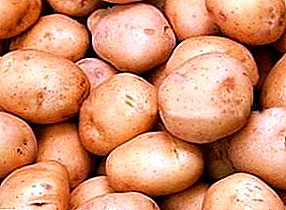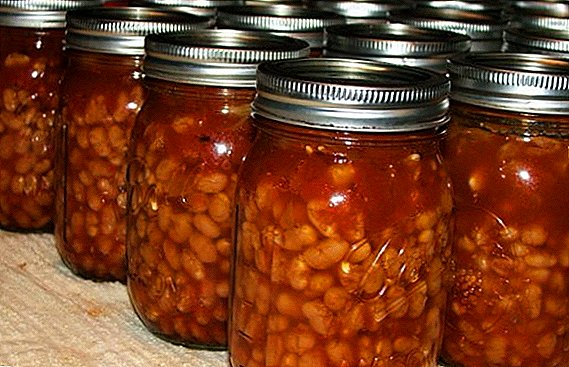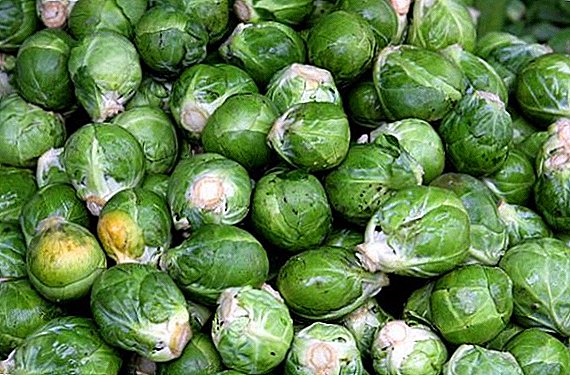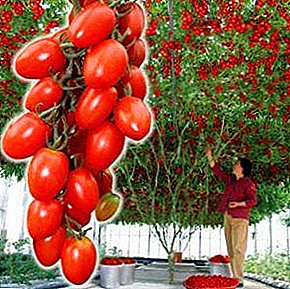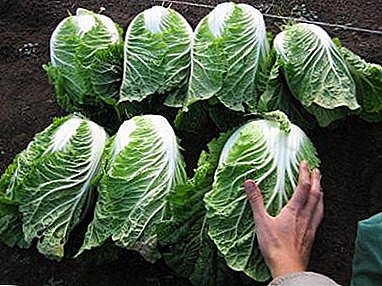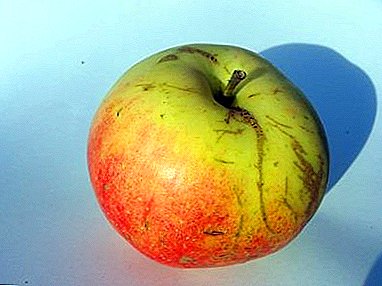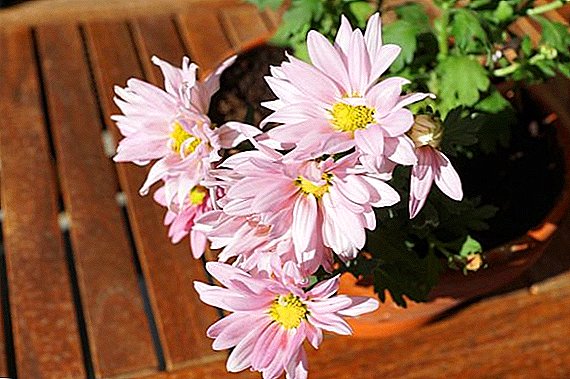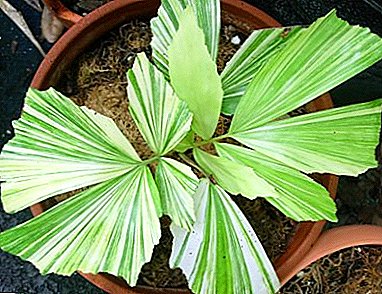
This palm can not be confused with anything - you only need to take a quick look at its leaves with torn edges, resembling either a half-open fan or fish tail.
That is the name of the people Kariotu - "Fish tail".
Kinds
In nature, they are more than a dozen, among them there are 10-meter giants, and modest trees, and even shrubs, but at gardeners 3 varieties are known mainly.
Soft (Gentle)
It is her - Caryota mitis most often grown in the house, appreciating the decorative. In the humid tropical forest, cariotes can sweep up to 5–7 meters in height, but in room content, its growth is easily limited.
The peculiarity of this type is multi-stemming. Each trunk blooms only once and gives fruit, and then dies off, but it is replaced by a new shoot, so that the palm tree lives for a long time.

And here is a video about young Caryota mitis.
Burning (Wine Palm, Kitul-Palma)
This species got its name due to small red berries containing burning substances. However, at home - the fruits are very rare, and Caryota urens bred because of the external attractiveness of the tree.
Wine palm is called this cariot because its inflorescences give palm sugar, from which wine is obtained by fermentation. And from the petioles of its leaves an extraordinarily strong fiber is made - “kitul”, with a string of wild elephant can be tied with it!

Rumpha (Fishtail)
No less popular among flower growers Caryota rumphiana. Like the burning one, the rumfa is a single-stemmed ornamental plant with a rich green “hair”, although in nature there are giants as tall as a five-story house.
Palm "Fishtail": photo of the plant.

Home care
Features care after purchase
Do not buy this heat-loving palm in winter - carriage in the cold can destroy it. It is better to wait for spring - not only because of the heat, but also because the purchased plant will soon need to be transplanted. And the best time for transplantation, which karyote transfers with difficulty is the beginning of spring.
After planting in a new pot, do not water the palm for three days, replace the watering with a spray.
Lighting
A child of the tropics - cariot loves light. The best option for her is bright but diffused rays. Although in the cold season, even direct sunlight will benefit her. But from April to September, a palm tree should not be left in the open sun at noon - you need to cover it in partial shade. In order for the crown of the cariota to be evenly thick and long, you need to rotate the plant pot 180 degrees twice a month.
Temperature
Comfortable growth range for cariota from 18 to 28 ° C, but remember, the hotter it is, the more often it needs spraying. In winter, the temperature should be moderate, not below +18. True, an adult plant can tolerate, without prejudice to the leaves, even a cooling down to 0 ° C, but not for long.
Air humidity
At home, the cariota air is humid, and in the summer heat it needs spraying. However, you should not do this if the day turned out to be dull and cold.
In the winter, especially if the palm tree grows near the battery, it needs to be sprayed in the morning and in the evening. Dry air and drafts are harmful to it. For spraying you need to take the settled water at room temperature.
Watering
 Watering a palm tree during the warm season should be more frequent and more abundant than on winter days. but soak in the water of the cariot should not - all that leaked into the pan should be drained immediately.
Watering a palm tree during the warm season should be more frequent and more abundant than on winter days. but soak in the water of the cariot should not - all that leaked into the pan should be drained immediately.
Karyote tolerates water scarcitythan its excess. Between watering the ground in a pot should have time to dry slightly.
Hard water for this palm is destructive. For irrigation, you can take otstoyannuyu rainwater or purchased.
If you take tap water, let it settle for a dayso that chlorine disappears - its cariot also does not like very much.
Fertilizers
In the period of growth (May - September) Cariot can be fed twice a month, it is suitable for ordinary palm fertilizer. But remember, if the air temperature is below 18 ° C - the roots of the palm will not digest the top dressing, wait for a warm day.
Bloom
Wait for the cariot flowers at home unlikely to succeed. But it is also for the better, as this palm tree blooms - once in a lifetime and, having borne fruit, perishes. Although her flowers are beautiful - from soft cream to purple, from a lot of hanging branches, similar to the horse's tail.
It is not terrible to bloom only with a multi-cariol soft; after all, not the whole plant will perish, but only the blossomed shoot.
Transfer
For this cariota the procedure is painfultherefore, it is necessary to resort to it only if the roots are already a rod from a pot. But then you should wait for spring. It should be borne in mind that with good care, the palm tree grows quite quickly, and if you do not need a two-meter tree, do not rush to replant it. Once every three years - quite enough. The rest of the time you can get by replacing the topsoil.
If the need has matured, it is necessary to transplant the cariot without destroying the earthy clod - by transshipment. If the roots have grown too much, you can cut off some of their "felt" with a sharp knife. Do not dig a palm tree in a pot - plant it at the same depth as before, focusing on the earthen ring on the trunk.
The soil for a palm tree is better to take neutral or slightly acidic, In the alkaline soil cariot can not assimilate many trace elements. You can use ready-made mixture for palm trees from the store. If you prepare the soil yourself, remember that the soil should easily give off excess moisture and maintain its porous structure for a long time.
The optimal composition is as follows: take humus-sheet and clay-soddy land in equal shares and add to this peat, sand and rotted manure.
Pruning cariota
Only obviously dried leaves can be removed from the cariota, and those that have turned green from yellow to brown are left. Palm takes nutrients from them.
Shaping the crown and removing the leaves when pruning, need to rememberthat it is impossible to take away from the plant more than what it has grown in a year. If there are more dried leaves on the cariot than new ones have appeared, the palm is definitely unhealthy.
Growing up
 Cariota seeds should be planted in early spring. Buying them in advance is not worth it, they quickly lose their germination. For a seed there is enough a pot the size of a glass.
Cariota seeds should be planted in early spring. Buying them in advance is not worth it, they quickly lose their germination. For a seed there is enough a pot the size of a glass.
Before sowing, slightly seed the seed rind, without touching the core, and soak the seeds in warm water (23-25 ° C) for two days. Water change every day.
Then the seeds are planted to a depth of 2-3 cm in a moist warm ground, which is then covered with polyethylene. Pots put in partial shade. After 3 months, the shelter can be removed.
Vegetative reproduction
Soft karyote - the only fish-tipped palm tree of all types, can be propagated vegetatively, due to its multiple character. Young stems, less than 10 cm long, should be divided so that each of them has roots.
Dig up the plant, shake off the ground from the roots and wash off the remnants of it with running water. Then cut with a knife the place of the root collar where the stalks are joined. Slices process copper-free fungicide. Split cariot stalks should be planted as soon as possible at the same depth as before and water the plant.
Diseases and pests
Cariothora is fairly resistant to infections, but sometimes it is affected by the fungus-induced Gelmintosporioznoe spot of leaves
External signs: dark spots appear on the leaves, often they are surrounded by a yellow border. If the disease progresses rapidly, the lesions merge to form islets of dead tissue.
What to do: Do not spray the plant - droplet moisture on the leaves and warm weather (23-30 ° C) causes germination of the fungus and further infection of the leaves. To reduce harm, give the palm as much light as it can bear.
Pests cariots - spider mites, scale insects, mealybug, whitefly.
Growing difficulties

- External signs: cariot does not grow or grows poorly. The leaves, especially the lower ones, turn yellow prematurely (chlorosis).
- External signs: young leaves turn yellow so that green veins stand out.
- External signs: the edges of the leaves dry on the contour (the so-called "regional burn").
- External signs: The lower leaves of the palm tree turn yellow from the edges to the center, but the veins remain green (chlorosis). It happens quite often.
- External signs: on the feathery leaves of the cariota appear elliptical spots, they are similar to the blotch resulting from fungal infection.
- External signs: the lower leaves of the palm tree are made brown at the tips, and fall off.
- External signs: Cariota leaves are covered with brown spots.
- External signs: In summer, yellow and brown specks appear on the leaves.
- External signs: leaves in pale spots, straw-colored, their ends curl like curls.
- External signs: palm crown becomes faded, light green. Cariot stops growing.
- External signs: old palm leaves are stained from yellow to bronze. At the ends of them visible tissue necrosis. The leaves begin to dry, while becoming orange.
- External signs: young leaves, cariots look small, weak, pale, with necrotic streaks visible on them.
Cause: palm lacks light and / or heat. Growth stops if the temperature is below + 18 ° C.
What to do: Move the “Fishtail” to a warm and bright place.
Cause: palm lacks iron and manganese due to alkalization of the soil.
What to do: increase soil acidity to normal (pH 5.6 - 7.5). In the morning or in the evening, conduct foliar dressing - spray the leaves not only from above, but also from below with liquid fertilizer for palm trees.
Cause: unsuitable for karyoty soil, too dense - retains moisture, does not let the air through.
What to do: reduce watering, completely or partially change the soil.
Cause: lack of magnesium. Perhaps due to the coolness (below 18 ° C), the palm tree cannot absorb the necessary substances from the soil.
What to do: to feed the cariothos with magnesium sulfate in two ways: spray the leaves and bring under the root.
Cause: copper poisoning.
What to do: Do not spray copper-containing fungicides for spraying. In the usual fertilizer for palm trees, if you do not exceed the dose, copper a little and it can not harm.
Cause: excess salt in the soil due to heavy fertilizing.
What to do: remove excess salt gradually using good soil drainage. You can partially change the top layer of soil. At the very least, transplant a palm tree.
Cause: excess boron in water.
What to do: take purified water for irrigation. Soil, plentifully shed clear water, with good drainage and immediately throw out all the water spilled from the pot.
Cause: too little light.
What to do: move the cariot to the lighter place.
Cause: direct sunlight daytime in summer.
What to do: move the palm to where the sun will not burn it.
Cause: not enough nitrogen.
What to do: feed either with palm fertilizer, or universal, such as “Rainbow”, “Ideal”.
Cause: lack of potassium.
What to do: apply fertilizer containing potassium salts. You can simply pour the special soil "The Queen of Flowers for Palm Trees", in it everything that the plant needs.
Cause: the plant lacks manganese, most often it happens either when alkalizing the soil - manganese does not dissolve in an alkaline medium, or at a low soil temperature.
What to do: You can add to the pot high-moor peat, needles or sawdust of coniferous trees, alder - this will make the soil more sour and manganese is absorbed by the plant. But it must be remembered that the needles and sawdust pull nitrogen from the soil, therefore, it is necessary to immediately introduce nitrogenous fertilizers.
Decorative Cariot palm is very responsive to taking care of it, its lush green crown looks great in spacious, full of light rooms.


